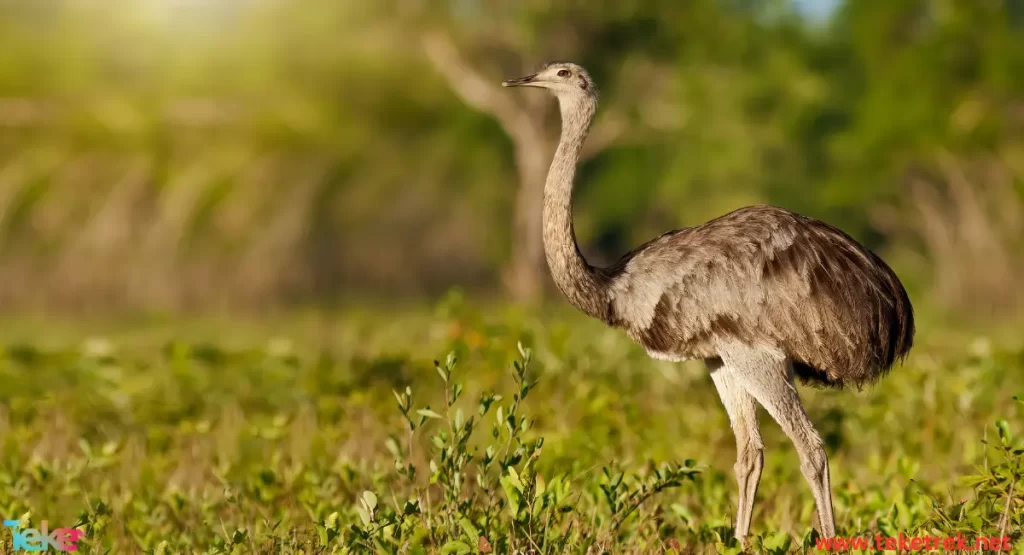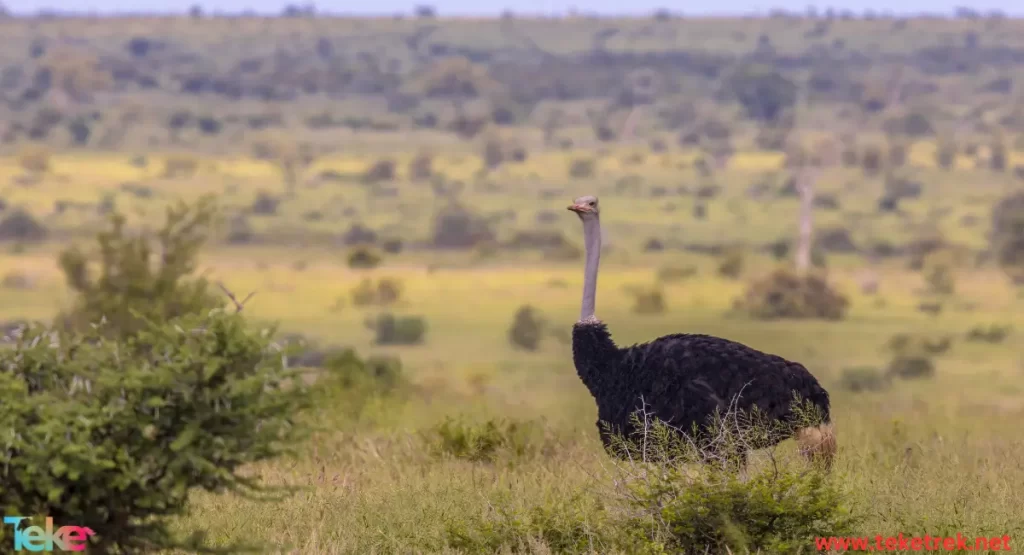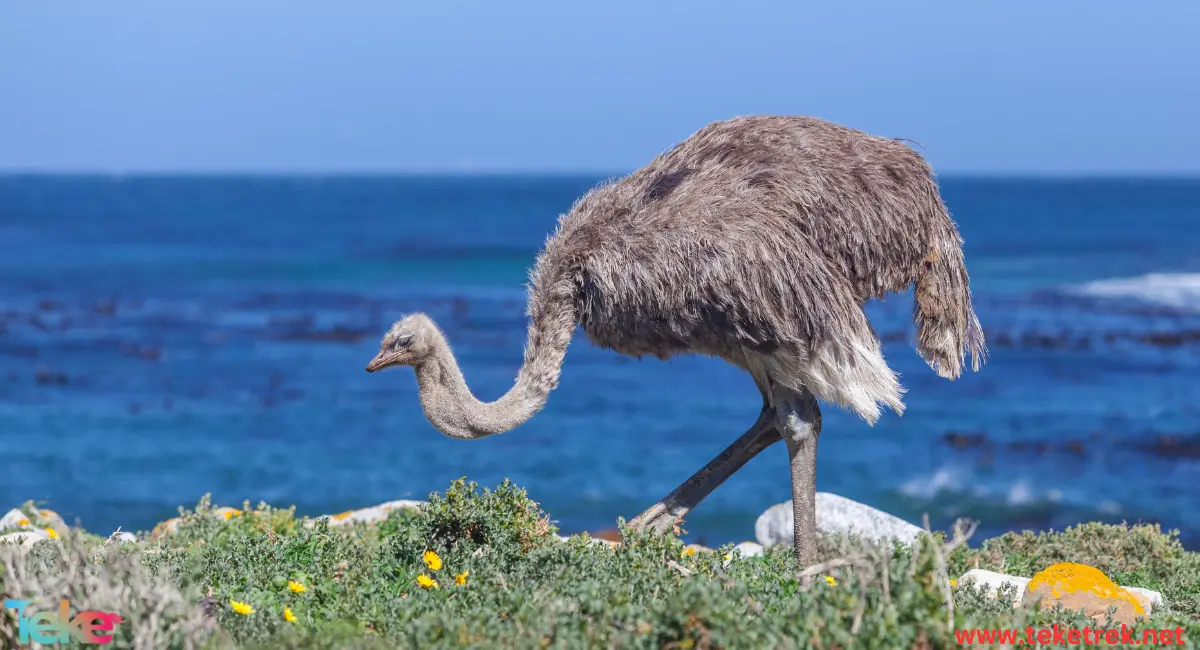This bird is one of the largest birds on Earth and is distinguished by its enormous size and strong and distinctive body structure. It is considered a flightless bird and inhabits rugged areas in Africa, Australia, and South America. The scientific name of the ostrich is “Struthio Camelus”.

Ostrich characteristics
- It is distinguished by its massive size, with males reaching a height of 2.1 to 2.75 meters and weighing between 100 to 130 kilograms or more. Females, on the other hand, have a length of about 1.75 to 1.9 meters and a weight ranging from 90 to 120 kilograms.
- Its appearance features soft, dense, loose, and lightweight feathers composed of separate filaments, aiding in adapting to various weather conditions in its environment.
- The colors of its plumage range from gray and brown to white, varying depending on the species and geographical location.
- Its head is small compared to its massive body, with a long and slender neck. The ostrich is also the only bird that has two toes on each foot.
- Its relatively large eyes, compared to its head, enable it to have a wide field of vision and sense many things in its surroundings.
- Considered one of the fastest birds on Earth, it can run at speeds up to 70 kilometers per hour, allowing it to escape from dangers quickly.
- Possessing keen eyesight and hearing, it can detect threats such as lions from a distance. Ostriches can escape at speeds exceeding 70-80 km/h and maintain a speed of 50 km/h, making them the fastest two-legged animals in the world. However, when threatened, they employ a unique defensive strategy. They lie down, hide their heads and necks on the ground, and use powerful kicks for defense and escape. Despite their effectiveness, these powerful kicks can cause serious injuries and even death. Notably, their legs are only capable of kicking forward.
- They have a lifespan of 40-50 years in the wild.
Why does the ostrich put its head in the dirt?
- Some images you may have seen depict ostriches with their heads deeply buried, sometimes appearing as if they are burying their heads in the sand or soil.
- This behavior is known as “Head Buried.” Despite the appearance of burying their heads in the sand, they do not do so entirely. They place their heads on the surface of the soil or sand, and it sometimes looks like they are inside the sand due to the nature of the image or the angle from which the photo was taken.
- People believe that ostriches exhibit this behavior for relaxation, enjoying a moment of quiet when they place their heads on the ground.
- At times, experts believe that this behavior serves as a strategy for hiding from predators or seeking refuge in moments of fear.
- This behavior may be part of their adaptation to environmental conditions, such as extreme heat or strong winds.
Homeland and origin
Ostriches commonly inhabit savannas and grasslands in Africa, but people also breed them in other parts of the world, such as Australia and South America. These birds hold significance in African culture and history.
Ostrich food
- Being primarily herbivorous, ostriches feed on a variety of plants. In the rugged and desert regions they inhabit, their diet heavily relies on the available vegetation. Additionally, they consume insects, making them omnivores as they eat both plants and invertebrates.
- Grasses and wild herbs constitute a significant portion of their diet. They graze on plant leaves and available grasses in meadows and prairies.
- Ostriches eat seeds and fruits available in their environment. They also swallow stones and sand, acting as gastroliths in their gizzard to aid in the mechanical breakdown of food.
- With an ability to adapt to dry conditions, they are believed to endure extended periods without needing substantial water. Ostriches benefit from the moisture present in the plants they consume.

Ostrich reproduction
The ostrich is non mammals animal, it reproduct by legs:
- The female ostrich typically constructs a simple nest, often in a dug-out hole in the ground, where she lays her eggs.
- The female lays approximately 20 eggs, and the average egg production for a female is around 60-100 eggs per season, with some laying up to 120 eggs. Ostrich eggs weigh between 1 to 1.5 kilograms.
- The incubation period for eggs ranges from 35 to 45 days.
- The female who laid the eggs incubates them, and typically, males take turns incubating them at night.
- Once the eggs hatch, the female, and sometimes the male, take care of the chicks.
- Sexual and physical maturity begins at a certain age, which can range from two to four years.
Uses of ostrich
The ostrich has several uses that can be beneficial to humans, including:
- Ostrich meat: People use its meat as a food source, it has a unique flavor and is rich in proteins.
- Ostrich feathers: used in the textile industry, clothing industry, and decorations. It is also used in the manufacture of brushes and decorative tools.
- Ostrich Leather: The leather industry uses its hides to produce things like shoes, bags, and belts.
- Ostrich eggs: People consider ostrich eggs a valuable food source and sometimes use them in cooking.
These uses demonstrate how the ostrich can serve as a valuable resource in a wide range of industries and meet various human needs.
Types of ostriches
There are three main breeds of ostrich:
- Red-necked : The largest and the most aggressive, but it produces fewer eggs.
- . Blue-necked : Medium-sized and produces a moderate amount of eggs.
- The African Black, the smallest in size, lays a significant number of eggs and faces endangerment in many countries.
These breeds inhabit various regions across Africa, with the Syrian ostrich breed having faced significant extinction in previous decades. These ostrich breeds continue to be threatened with extinction in many countries.
FAQ
- What is special about ostrich bird?
The ostrich is a bird, but it does not fly. It is very fast in running, its long legs cover 10 feet per step.
- How Fast is an Ostrich?
The speed of an ostrich is about 43 miles per hour.
- What does a ostrich eat?
The ostrich is a carnivorous animal that feeds on small animals, including mice, frogs, and lizards, but it also eats some leafy vegetables, roots, herbs, sap, and sometimes fallen fruit.
- Are ostriches friendly?
Ostriches stay away from humans as they consider them potential predators.
- Is an ostrich a bird or an animal?
The ostrich is an animal from the order of birds.
In conclusion, people consider the ostrich a fascinating and unusual creature in the bird world because of its large size and distinctive lifestyle in the prairies.






